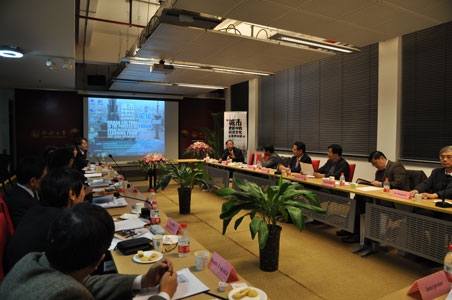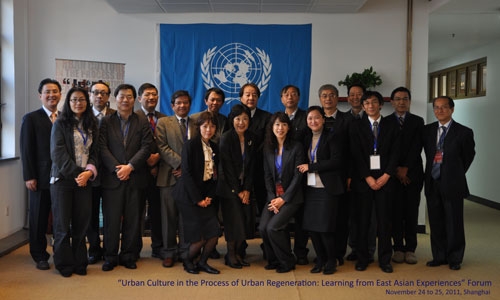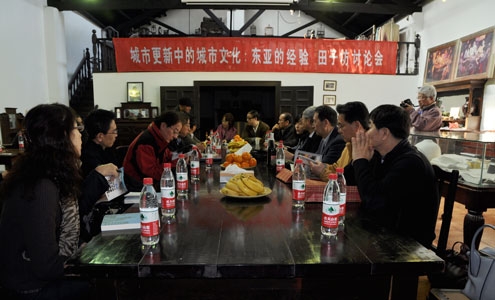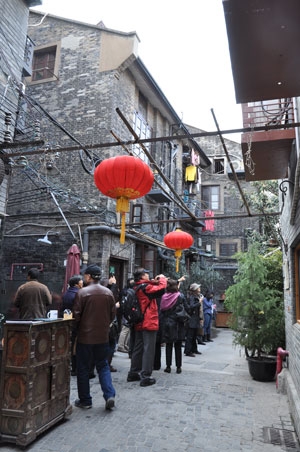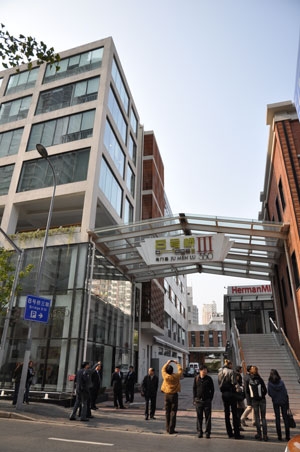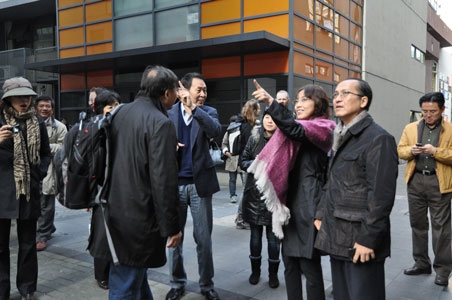| “Urban Culture in the Process of Urban Regeneration: Learning from East Asian Experiences” Forum Held at WHITRAP Shanghai |
| From:WHITRAP Shanghai PublishDate:2011-11-28 Hits:5220 |
On November 24th and 25th, “Urban Culture in the Process of Urban Regeneration: Learning from East Asian Experiences” Forum was held successfully at Tongji University. This forum was jointly hosted by Tongji University, Fudan University, Rikkyo University (Japan), University of Seoul (Korea), UNESCO WHITRAP Shanghai, and Shanghai Research Centre of Chinese Culture and Creation. It was aimed at promoting the comparative study of urban culture in East Asia, especially in the research and comparison of developing cultural trends in creative industries and in the preservation of the cultural landscapes of old parts of East-Asian megacities in the context of urban regeneration that has swept the globe since the 1990s. On November 24th, Professor WU Jiang, Vice President of Tongji University, introduced the history of Shanghai architectural preservation and the general practices of historical conservation and urban renewal. Professor ZHOU Jian of Tongji University, Director of UNESCO WHITRAP Shanghai, introduced the conservation of urban heritage in real estate projects and the alternative path of conservation and renovation of historic districts showing the example of the Shanghai Old City, and he also reflected on the social consequences of the renovation. Professor YU Hai of Fudan University illustrated the significance of the sustainable development of Tianzifang: How to maintain and foster vitality in a legitimized framework is an unavoidable question facing administrations; and furthermore, a topic of how to include local experimental autonomy in a state-led market structure to promote the development of a national innovation system. Mr. Su Binggong, Director of Shanghai Research Centre of Chinese Culture and Creation, analyzed the differences among Xintiandi, Tianzifang, the Bridge 8 and Zhizaoju as models of creative industry developments and stated that these different models show the significance of taking different paths according to the specific cultural conditions of each site, but he also stated that the outcomes of these paths are always the same: promoting the vitality of neighborhood commerce transformed by thriving tourism, which in turn highlights the character of local culture and forms a positively integrated chain of commerce, tourism and culture. Professor Wonho JANG of University of Seoul described the concept of the ‘Urban Scene’ and its importance in urban policy planning. He went on to analyze how scenes can influence the values and identities of the residents as well as the relationship between scenes and housing prices. Dr. Shiho NISHIYAMA of Rikkyo University, focusing on urban regeneration and the potentials of governance, proposed that it is very important to ensure the civil sector’s independence and to build up an equal role with other sectors to establish a governance system. He went on to analyze the possibilities and mechanisms of governance promoted by Social Enterprise at the local level. In addition to the above, other professors and experts also delivered insightful speeches, including Professor Tetsuo MIZUKAMI of Rikkyo University, Professor Yoshihiko KURODA of Nagoya University, Professor Yaeko NISHIYAMA of Kinjo Gakuin University, Part-time Professor XU Chunyang of Meijo University, Professor PAN TianShu of Fudan University, and Professor Kee-Bom NAHM of University of Seoul, Director of Center for Urban Society and Culture. On November 25th, all guests attended a site visit to several urban renewal projects including Zhizhaoju (stage I & II), the Bridge 8 (stage II & III), Tianzifang, Sinan Mansions and M50 Creative Park. The foreign experts and scholars expressed their great interest in the development models of urban regeneration and creative industries in Shanghai.
on the Scene Group Photo
Communication in Tianzifang Site Visit: Tianzifang (left), No.8 Bridge (right) |
- Documentary: 2023 World Heritage Creative X Innovators Conference and the AWHEIC Third Anniversary Celebration
- Publication | WHITRAP Newsletter No. 61
- Mt. Huangshan first show in Climate Action for World Heritage
- Call for Good Practices: 2024 Environment and Resilience
- FAQs | 2024 Call for Good Practices
- Operational Guidelines for the Implementation of the World Heritage Convention 2017
Copyright © 2009-2012 World Heritage Institute of Training and Research-Asia and Pacific (shanghai)


